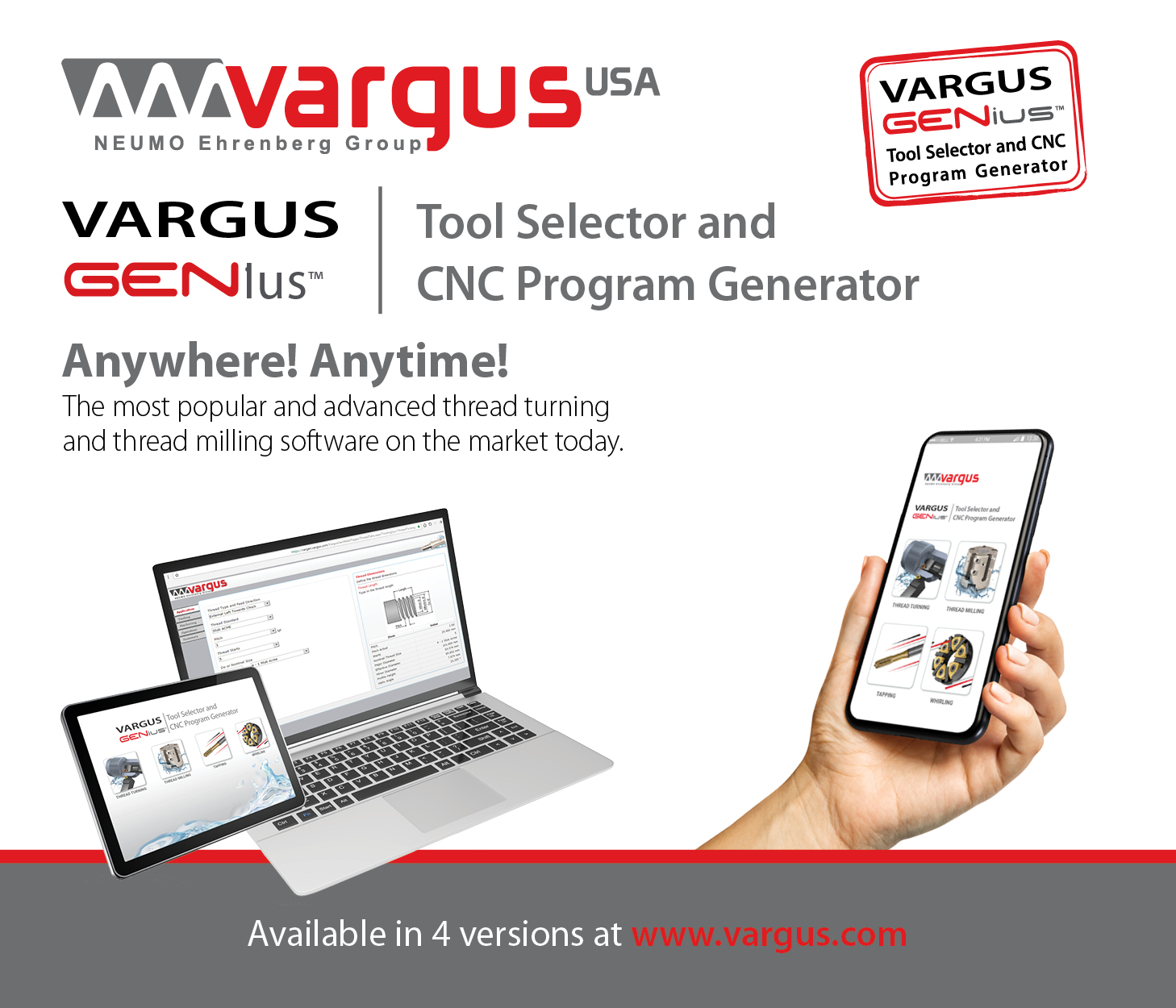A milestone in the 3D printing revolution is the appearance of CNC metalcutting machine tools incorporating additive-manufacturing capabilities. Manufacturers of the hybrid additive/subtractive systems tout their advantages over conventional machine tools, but the hybrids raise important issues that their builders and users must address.
A selling point of hybrids is they allow a part to be completed in one setup. “With metal additive manufacturing, the part finish is rough, so it requires machining,” said Ken Vartanian, vice president of marketing at Optomec Inc., Albuquerque, N.M., a supplier of additive-manufacturing systems. Using a hybrid machine tool, “the operator can build up and finish-machine a part all on the same machine.”

Optomec’s LENS process adds material to resurface a shaft. LENS is the additive process employed in the company’s hybrid machines. Image courtesy of Optomec.
Or consider the repair of a part like a turbine blade. Vartanian said this process usually starts with a machining step to remove material, such as a corroded area. Then an additive step builds the blade back up, followed by finish machining of the deposited material. If a hybrid isn’t used for this process, Vartanian said, the part may be moved multiple times between two machines.
Optomec entered the hybrid arena last year through its LENS series, which has configurations combining a compact CNC mill platform with the company’s LENS (Laser Engineered Net Shaping) metal-additive-manufacturing process.
Another hybrid unveiled last year was the Vertex 55X-H from Mitsui Seiki USA Inc., Franklin Lakes, N.J. Suitable for repairing aerospace, energy, power-generation and other parts, the 55X-H combines a vertical machining center with a spindle-adapted, laser direct-energy deposition, powder-fed nozzle.
Besides handling tasks that require both adding and subtracting material, hybrids can serve as straight additive or subtractive machines. An owner could run a hybrid as an additive machine for weeks at a time, then convert it to a straight-up milling machine by exchanging the additive processing nozzle for a suite of milling tools, noted Robb Hudson, CEO of Mitsui Seiki USA.
Because the same automation platform moves both its additive and subtractive components, a hybrid is an economical choice for machine tool purchasers who want additive manufacturing in their shops. Vartanian said buying additive capabilities this way can easily reduce capital acquisition costs by half.
Manufacturers can save even more by retrofitting an existing machine tool to 3D-print. Hudson estimated that retrofitting may be a good solution for simple 2- or 3-axis work that involves printing a little material and then machining it to a moderate tolerance.

The Vertex 55X-H from Mitsui Seiki USA adds a laser direct-energy deposition, powder-fed nozzle to a VMC. Image courtesy of Mitsui Seiki USA.
For complex 5-axis parts with tight tolerances, however, Hudson recommends “a more sophisticated integration,” such as that offered by the 55X-H, which uses the same CNC for generating additive and subtractive toolpaths.
Creating a hybrid means more than tacking additive-manufacturing equipment onto a standard machine tool. For one thing, hybrid designers must ensure that laser light always will be safely contained. Vartanian said this task includes making the chamber “light tight.” This step eliminates any gaps in the chamber and adds a hood to CNC machines open on top. Other safety precautions include installing protective laser glass for machine windows and doors, as well as equipping doors with interlocks that send a signal to shut off the laser if an operator reaches inside the machine during the additive process.
Then there’s the need to keep loose additive process powder from entering the machine mechanism and causing damage. Optomec prevents powder problems with plastic or metal covers formed to fit around the ways and stages, while Mitsui Seiki USA employs way covers along with guide way wipers. Both items are part of a package the company developed for machines for milling graphite electrodes.
Many are curious about additive manufacturing but don’t know where it would fit into their operations, said Vartanian. He recommends this progression for hybrid purchasers: “Start by thinking of it as a repair tool that allows you to do a full part repair with one machine—it cuts away bad material, builds up the part again and finish-machines. As your expertise grows, start building parts from scratch and finish machining them.”
Related Glossary Terms
- computer numerical control ( CNC)
computer numerical control ( CNC)
Microprocessor-based controller dedicated to a machine tool that permits the creation or modification of parts. Programmed numerical control activates the machine’s servos and spindle drives and controls the various machining operations. See DNC, direct numerical control; NC, numerical control.
- gang cutting ( milling)
gang cutting ( milling)
Machining with several cutters mounted on a single arbor, generally for simultaneous cutting.
- lapping compound( powder)
lapping compound( powder)
Light, abrasive material used for finishing a surface.
- machining center
machining center
CNC machine tool capable of drilling, reaming, tapping, milling and boring. Normally comes with an automatic toolchanger. See automatic toolchanger.
- metalcutting ( material cutting)
metalcutting ( material cutting)
Any machining process used to part metal or other material or give a workpiece a new configuration. Conventionally applies to machining operations in which a cutting tool mechanically removes material in the form of chips; applies to any process in which metal or material is removed to create new shapes. See metalforming.
- milling
milling
Machining operation in which metal or other material is removed by applying power to a rotating cutter. In vertical milling, the cutting tool is mounted vertically on the spindle. In horizontal milling, the cutting tool is mounted horizontally, either directly on the spindle or on an arbor. Horizontal milling is further broken down into conventional milling, where the cutter rotates opposite the direction of feed, or “up” into the workpiece; and climb milling, where the cutter rotates in the direction of feed, or “down” into the workpiece. Milling operations include plane or surface milling, endmilling, facemilling, angle milling, form milling and profiling.
- milling machine ( mill)
milling machine ( mill)
Runs endmills and arbor-mounted milling cutters. Features include a head with a spindle that drives the cutters; a column, knee and table that provide motion in the three Cartesian axes; and a base that supports the components and houses the cutting-fluid pump and reservoir. The work is mounted on the table and fed into the rotating cutter or endmill to accomplish the milling steps; vertical milling machines also feed endmills into the work by means of a spindle-mounted quill. Models range from small manual machines to big bed-type and duplex mills. All take one of three basic forms: vertical, horizontal or convertible horizontal/vertical. Vertical machines may be knee-type (the table is mounted on a knee that can be elevated) or bed-type (the table is securely supported and only moves horizontally). In general, horizontal machines are bigger and more powerful, while vertical machines are lighter but more versatile and easier to set up and operate.
- milling machine ( mill)2
milling machine ( mill)
Runs endmills and arbor-mounted milling cutters. Features include a head with a spindle that drives the cutters; a column, knee and table that provide motion in the three Cartesian axes; and a base that supports the components and houses the cutting-fluid pump and reservoir. The work is mounted on the table and fed into the rotating cutter or endmill to accomplish the milling steps; vertical milling machines also feed endmills into the work by means of a spindle-mounted quill. Models range from small manual machines to big bed-type and duplex mills. All take one of three basic forms: vertical, horizontal or convertible horizontal/vertical. Vertical machines may be knee-type (the table is mounted on a knee that can be elevated) or bed-type (the table is securely supported and only moves horizontally). In general, horizontal machines are bigger and more powerful, while vertical machines are lighter but more versatile and easier to set up and operate.
- tolerance
tolerance
Minimum and maximum amount a workpiece dimension is allowed to vary from a set standard and still be acceptable.


 ARTICLES
ARTICLES

